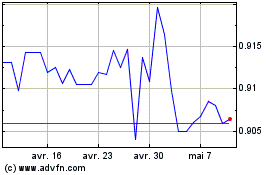Dollar Mixed After ADP Private Payrolls Data
04 Janvier 2018 - 10:10AM
RTTF2
The U.S. dollar came in mixed against its key counterparts in
the European session on Thursday, following a data showing better
than expected U.S. private sector employment growth in
December.
Data from payroll processor ADP showed that employment in the
private sector surged up by 250,000 jobs in December after climbing
by a downwardly revised 185,000 jobs in November.
Economists had expected an increase of about 190,000 jobs,
matching the job growth originally reported for the previous
month.
Separate report from the Labor Department showed that initial
jobless claims unexpectedly inched higher in the week ended
December 30th.
The report said initial jobless claims edged up to 250,000, an
increase of 3,000 from the previous week's revised level of
247,000.
Economists had expected jobless claims to drop to 240,000 from
the 245,000 originally reported for the previous week.
Investors await non-farm payrolls report due tomorrow for more
clues about the health of the labour market.
The economy is forecast to have added 188,000 jobs in December,
compared to 228,000 in November. The jobless rate is forecast to
remain at 4.1 percent.
The greenback fell against its European major counterparts early
in the European session, as the latest FOMC meeting minutes
revealed that the Fed would continue a gradual path of tightening
as policy makers wrangle over the inflation outlook.
The currency showed mixed performance in the Asian session.
While it dropped against the euro and the pound, it held steady
against the franc. Against the yen, the currency rose.
The greenback weakened to 0.9745 against the franc, compared to
0.9770 hit late New York Wednesday. The greenback may challenge
support around the 0.96 mark.
The greenback resumed its early gains against the yen, touching
a 6-day high of 112.84. The greenback is seen finding resistance
around the 114.00 level.
Survey from Nikkei showed that Japan's manufacturing sector
continued to expand in December, and at an accelerated pace, with a
manufacturing PMI score of 54.0.
That's up from 53.6 in November, and it moves further above the
boom-or-bust line of 50 that separates expansion from
contraction.
The greenback reclaimed some of its lost ground against the
pound, trading at 1.3542. This may be compared to a low of 1.3560
hit at 7:15 am ET. If the greenback extends rally, 1.34 is likely
seen as its next resistance level.
Survey data from IHS Markit showed that British service sector
growth accelerated at a faster-than-expected pace in December.
The IHS Markit/Chartered Institute of Procurement & Supply
Purchasing Managers' Index, rose to 54.2 in December from 53.8 in
November. Economists had expected the index to rise to 54.0.
The greenback fell further to a 2-day low of 1.2075 against the
euro, off its early high of 1.2005. The next possible support for
the greenback is seen around the 1.23 area.
Final data from IHS Markit showed that Eurozone private sector
expanded the most since early 2011 driven by a near-record
expansion of manufacturing and the steepest rise in service sector
for over six-and-a-half years.
The composite output index rose to 58.1 in December from 57.5 in
November. This was the highest score since February 2011.
Markit's U.S. final services PMI data for December is due
shortly.
US Dollar vs CHF (FX:USDCHF)
Graphique Historique de la Devise
De Mar 2024 à Avr 2024

US Dollar vs CHF (FX:USDCHF)
Graphique Historique de la Devise
De Avr 2023 à Avr 2024
